Edward H. “Ted” Holmes

In 1906, Ted Holmes was born in Kingston, Massachusetts, close by to Plymouth. By the time he was 10, the Federal-Aid Road Act of 1916 had become the first national Federal-aid program. Holmes knew nothing of it at the time, nor did he realize that he later would join the Bureau of Public Roads in what would become an intimate partnership lasting 40 years. The value of that merger is still reflected in the quality of highway programs both in the United States and abroad.
Holmes graduated with a degree in civil engineering from the Massachusetts Institute of Technology in 1928. Having spent a summer as a student engineer making time studies for the Bureau of Public Roads, he returned to the Bureau after graduation as a trainee, the launching pad for most BPR engineers. Holmes once remarked that at this point he probably envisioned his future as that of a highway contractor or superintendent.
That vision changed, however, when he was chosen in 1929 for a fellowship in the new field of traffic engineering at Harvard University, from which he graduated with a master’s degree in 1930. From that time on, Ted Holmes was to devote his entire career to highway research and planning.
From his earliest endeavors, he pioneered in the development of workable solutions for both short- and long-range demands. His early efforts in the Bureau of Public Roads included the planning, adaptation, and design of equipment and scientific techniques to measure the traffic characteristics essential to sound traffic planning, design and engineering. The now common practice of counting traffic with pneumatic detectors was just one of the revolutionary steps that stemmed from these studies. In the mid-1930’s he had a major role in establishing the Federal-aid statewide highway planning surveys which provided an appropriate foundation for the continuing Federal and State highway programs.
Among his goals were the pursuit, development and encouragement of a supporting staff. Individually and collectively, those men were or became outstanding experts in their fields. This was due in principal measure to Holmes’ ability to forge effective teams from talented individuals and to give each one an opportunity to reach his potential.
Holmes’ direction and counsel were invaluable throughout the many years when highway research and planning served as the keystone of the Nation’s highway transportation programs. Through the 1940’s and 1950’s, he guided the development of the urban factual surveys and analyses of traffic and urban development. These later evolved into a scientific linking of transportation to land use which is now known internationally as the “3 C” (comprehensive, continuing, cooperative) State-local planning process. This innovation in urban transportation planning, perhaps the most notable of all Ted Holmes’ many contributions, was subsequently extended to statewide planning. The key to the success of that endeavor was the development of a high degree of cooperation among Federal, State, and local officials that perhaps reached its high point with the Williamsburg Conference in 1965, which he chaired.
Holmes’ efforts covered many diverse subjects related to transport. Among these was his discovery of a significant parallel between trends in vehicle mileage (VMT) and the Gross National Product. In a speech in 1950, he advised his audience that they should expect an increase in traffic over the next 15 years of at least 4 percent annually. Although at the time this forecast met with almost universal doubt, in 1965 the average rate had been 4.1 percent. Not all forecasters have been that fortunate!
284
